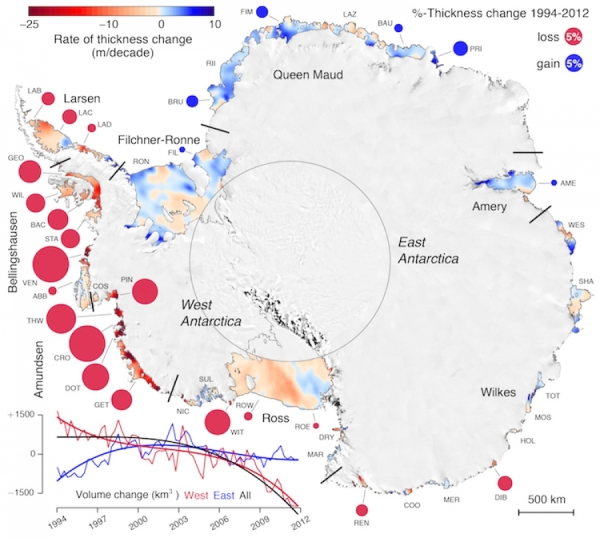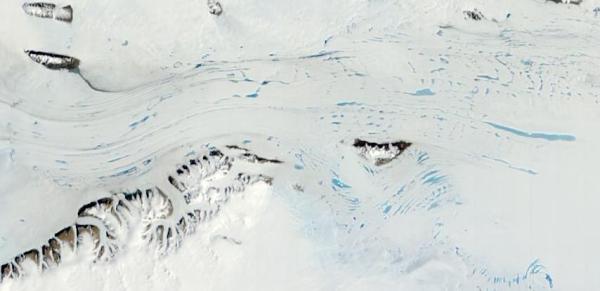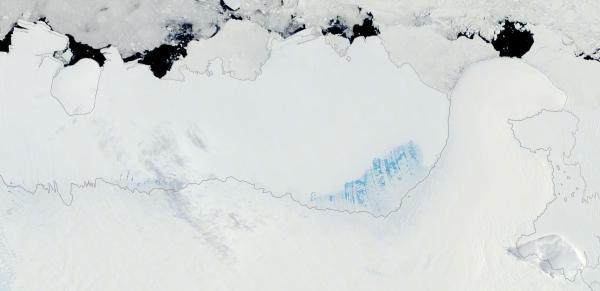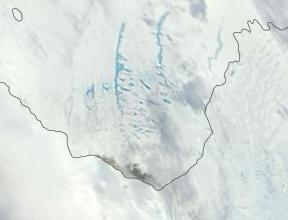Abnormal Antarctic Heat, Surface Melt, Giant Cracks in Ice Shelves — More Troubling Signs of a World Tipping Toward Climate Chaos
23
January, 2017
Around its edge zone, and from glacier top to ice shelf bottom, Antarctica is melting. Above-freezing surface temperatures during the austral summer of 2016-2017 have resulted in the formation of numerous surface-melt ponds around the Antarctic perimeter. Large cracks grow through Antarctic ice shelves as warmer ocean currents melt the towering glaciers from below. The overall picture is of a critical frozen region undergoing rapid change due to the human-forced heating of our world — a warming that has brought Antarctica to a tipping point, for such fundamental alterations to Antarctic ice are now likely to bring about a quickening rate of sea-level rise the world over.
Surface
Melt Visible From Satellite
During
2016-2017, Antarctic surface temperatures ranged between 0.5 and 1
degree Celsius above
the already warmer-than-normal 1979 to 2000 average for
most of Southern Hemisphere summer. While these departures for this
enormous frozen continent may not sound like much at face value,
they’ve translated into periods of local temperatures up to 20 C
above average. As a result, measures around Antarctica along and near
the coastal zone have risen above the freezing mark on numerous
occasions. These periods of much-warmer-than-normal weather have in
turn precipitated widespread episodes of surface melt.
(This
Antarctic volume-change melt map, which tracks thinning along various
coastal ice shelves from 1994-2012, provides a good geographical
reference for ice shelves experiencing surface melt or severe
rifting. The Amery Ice Shelf [AME], King Baudouin Ice Shelf [BAU],
and the Lazarev Ice Shelf [LAZ], stable through 2012, all showed
extensive surface melt this summer. Meanwhile the Larsen C Ice Shelf
[LAC] and Brunt Ice Shelf [BRU] both feature large rifts that
threaten destabilization. Image source: Volume
Loss from Antarctica’s Ice Shelves is Accelerating/Sciencemag.org.)
This
year, one region in particular has seen temperatures hitting above 0
C consistently: the valley into which the Lambert, Mellor, and Fisher
glaciers flow into the Amery
Ice Shelf.
There, warming has resulted in the formation of multiple large
surface-melt ponds. The below image is a January 22nd NASA satellite
shot of an approximate 100-by-40-mile section of this glacial outflow
zone. The blue areas are melt ponds, some as large as 3 miles
wide and 20 miles long.
The
Amery Ice Shelf is one of East Antarctica’s largest. Like many of
Antarctica’s ice shelves, Amery is melting, with about
46 billion tons of ice lost from this shelf alone each year.
As with other Antarctic ice shelves, Amery’s melt is
mostly below the
surface, caused by warming ocean waters. However, in recent
years, considerable surface melt on Amery’s feeder glaciers
likely also contributed to significant volume losses in the self.
(Large
melt ponds up to 20 miles long cover glaciers flowing into the Amery
Ice Shelf on January 22, 2017. Image source: LANCE
MODIS.)
Surface
melt for Amery has become an increasingly prevalent feature since
2013, with 2017 melt for January 22 the most widespread for any of
the past five years in this region. East Antarctica rarely saw large
surface melt events prior to the 2000s, and this year’s warming and
large melt ponds are a considerable feature. While basal warming is
often the cause of the greatest mass losses, surface melt can act
like a giant wedge driven into ice shelves, helping to break them up.
Melt wedging in glaciers can also increase their forward rate of
movement as heat content rises and as the points at which glaciers
contact the ground become lubricated.
Moving
north toward Dronning Maud Land along the East Antarctic coast, we
find another region of surface melt ponding on the King
Baudouin Ice Shelf.
Nearly as widespread and extensive as the melt on the Amery
Shelf’s glaciers, the King Baudouin melt is no less impressive and
concerning.
(King
Baudouin Ice Shelf shows extensive melt ponding along a 40-mile swath
of its southwestern corner in January 2017. Image source: LANCE
MODIS.)
The
largest melt zone shows nearly continuous ponding along a
40-mile-wide diagonal near the ice shelf’s southwestern contact
point with East Antarctica’s mainland. A smaller section of melt
appears as light blue splotches about 60 miles to the west of the
larger melt zone in the image above (for reference, bottom edge of
frame represents about 250 miles).
Unlike
glacial surface ponding near Amery, melt on King Baudouin occurs
directly over the floating ice shelf. This form of melt adds greater
stresses as the heavy pools of water can act as wedges that drive
gaps in the ice apart. Past instances of widespread surface ponding
have occurred in conjunction with the rapid break-up of Larsen ice
shelves along the Antarctic Peninsula. Taking a look at past years in
the satellite record, we find that this region of King Baudouin has
been susceptible to melt since at least 2013. However, the extent of
2017 melt is the greatest in the record for this time of year.
The
next ice shelf to the west of King Baudouin, the
Lazarev Ice Shelf, shows
extensive melt along what appear to be various rifting features
streaming out from an open ocean gap where the ice shelf contacts
land:
(Ten-mile-long
melt ponds visible on the surface of the Lazarev Ice Shelf. Image
source:LANCE
MODIS.)
Over
recent years, the ocean gap — visible as a dark section in
center-bottom frame of the image above — has slowly grown larger.
There, open ocean water has gradually taken up a larger and larger
section of Lazarev’s land-contact point. Meanwhile, from 2013
to 2017, melt ponds have tended to radiate out from this open
gap region along rifts in the ice shelf structure during summer as
air temperatures have risen above freezing.
This
year, melt appears to be quite extensive with two parallel
10-mile-long melt ponds filling in rift features with many smaller
melt ponds interspersed. The open ocean gap combined with rifts
filling with what is now seasonal melt water gives the overall
impression of a rather weak structure.
Ice
Shelves Cracking Up
Though
regions on or near the Amery, King Baudouin and Lazarev Ice Shelves
show the most obvious surface melt features, large melt ponds also
formed near the Fimbul Ice Shelf. Ponds also formed during
a Föhn wind event near
the Drygalski
Ice Tongue.
Even as such instances of surface melt became a more obvious feature
across Antarctica, at least two large ice shelves were run through by
growing rifts that threatened their stability.
One
such rapidly-expanding rift forced the British Halley VI research
team to evacuate their base of operations on the floating Brunt Ice
Shelf. This rift, which had until late 2016 been growing only
gradually, doubled in length in less than three months. Its
gaping chasm threatened to cut the expedition off from the Antarctic
mainland and set it adrift at sea —forcing
an early evacuation as a precaution.
(Drone
footage of Brunt Ice Shelf’s rapidly growing crack. From October
through early January, the crack doubled in size from 22 kilometers
in length to 44 kilometers. Video source: Antarctic
Survey.)
Meanwhile, a
large crack that will soon result in a 2,000-square-mile iceberg
breaking from the Larsen C Ice Shelf recently grew by another
six miles to 100 miles long.
The Connecticut-sized ice chunk now only hangs by a 15 to 20 mile
thread. With the loss of this very large segment of ice, researchers
are concerned that Larsen C may destabilize and ultimately succumb to
the fate of Larsen A and Larsen B — breaking into thousands of
separate icebergs and floating away into the Southern Ocean.
Signs
of Melt, Destabilization as More Above-Freezing Temperatures are on
the Way
With
so many large melt ponds and melt-related rifts forming in
Antarctica’s ice shelves, it’s worth considering that these
shelves serve as a kind of door jam holding large glaciers back from
flooding into the ocean. And as more ice shelves melt and
destabilize, the faster these glaciers will move and the faster the
world’s oceans will rise.
So
much widespread melt and rifting of Antarctica’s ice shelves is a
clear warning sign. And if enough of the ice shelves go, then rates
of sea-level rise could hit multiple meters this century.
(Many
locations along the coast of Antarctica will see 5-15 C above-average
surface temperatures this week, a continuation of a strong surface
melt pressure for the austral summer of 2016-2017. Image
source: Climate
Reanalyzer.)
This
week, another spate of near- or above-freezing temperatures will run
along the coastal regions of both east and west Antarctica, so the
amazing atmospheric melt pressure that we are now seeing should
continue to remain in play at least for the next seven days as
austral summer continues. As for the melt pressure coming from the
warming ocean beneath the ice shelves — that is now a year-round
feature for many locations.
Links:
Hat
tip to Shawn Redmond
Hat
tip to Jeremy in Wales
Hat
tip to Colorado Bob








No comments:
Post a Comment
Note: only a member of this blog may post a comment.